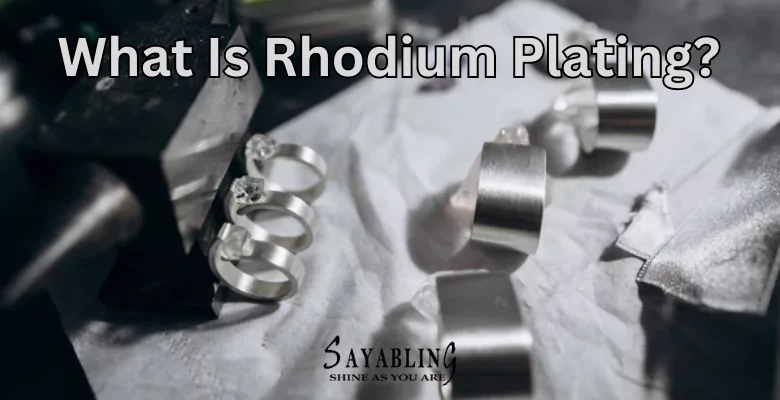What is Rhodium?
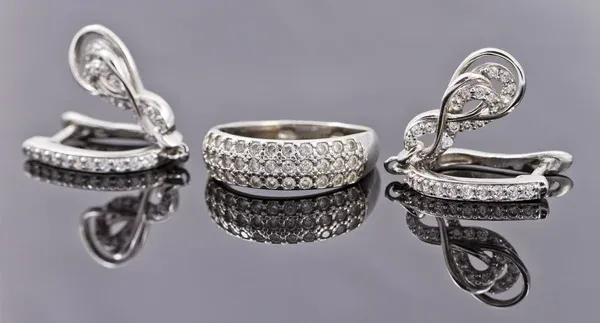
Rhodium is the whitest, rare, most expensive metal, is highly prized in the jewelry industry, and was first discovered in 1803. It is not directly mined, but extracted as a byproduct from platinum or nickel mines, adding to its allure.
It comes from the platinum group, including metals such as Platinum, Rhodium, Iridium, Ruthenium, Osmium, and Palladium. It has been used in other industries such as automobile manufacturing and mirrors due to its extreme shine, reflectiveness, and strength. Most of the world’s rhodium comes from mines in South Africa, with only 20 tons being mined annually.
What is Rhodium Plating?
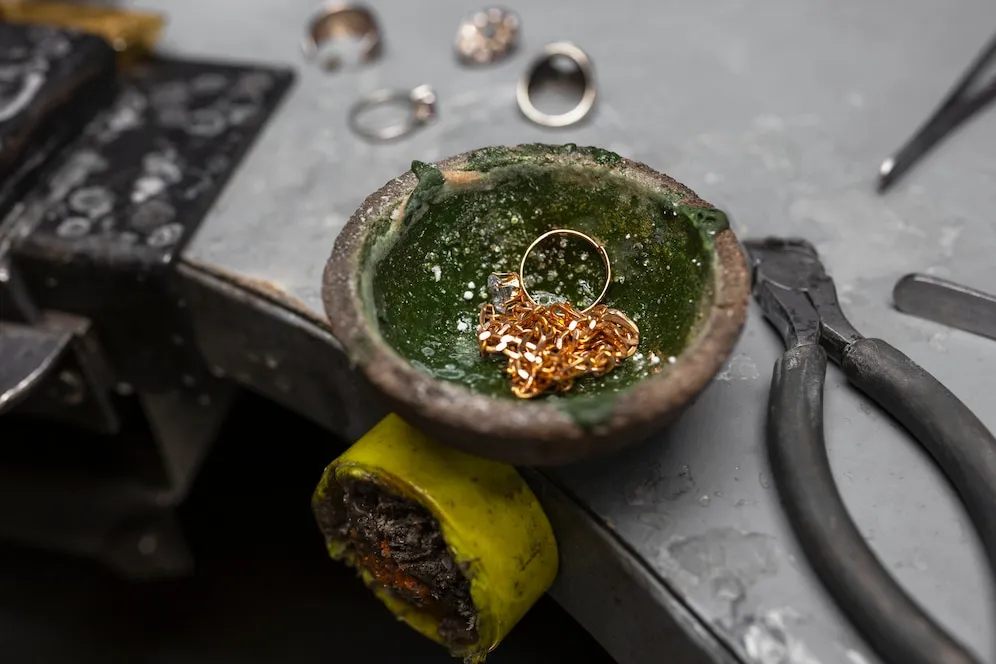
Rhodium plating, often called rhodium dip or rhodium flashing, refers to the process of applying a thin layer of rhodium, a rare and highly reflective metal, onto the surface of jewelry, usually made of gold, silver, or platinum. Jewelry plated in rhodium is shinier and more durable than other metals.
Rhodium plating does not scratch, dent, or corrode and retains its luster. This coating can even camouflage imperfections, leaving your jewelry looking flawlessly pristine. Rhodium is a vibrant, silvery-white metal that is highly reflective. Rhodium plating is used on jewelry because of its brilliance and quality.
Other colors such as black, rose, or yellow can be added to rhodium through ink binding. Black can be added to rhodium by binding black ink to the metal during plating. Black rhodium plating has an edgy, mysterious look, but it is expensive to maintain. Rhodium plating must be touched up occasionally, and requesting black rhodium replating adds to the cost.
How is Rhodium Plating Done?
Here are the main points of the rhodium plating process:
- Jewelry is thoroughly cleaned (ultrasonic cleaners or steam cleaning) to remove dirt, oils, or debris.
- Cleaning ensures the rhodium plating bonds evenly
- Jewelry is rinsed in distilled water to remove any remaining cleaning agents or particles.
- Jewelry is dipped in a mixture of sulfuric acid and rhodium sulfate.
- Immersion time: 30-60 seconds, depending on the jewelry’s fineness.
- Jewelry is suspended in the solution using conductive hooks (made of silver or copper).
- A positive electrical current is applied to bond the rhodium to the jewelry.
- Jewelry acts as the cathode, and rhodium dissolved in the solution acts as the anode.
- Jewelry is rinsed again in distilled water to remove residual chemicals.
Equipment Used in the process:
- Rhodium plating kit: Contains vessels for rinsing and chemical solutions.
- Conductive hooks: Made of silver or copper to conduct electricity.
- Rhodium plating solution: A mixture of sulfuric acid and rhodium sulfate.
- Power source: Provides the electrical current for electroplating.
Types of Rhodium Plating
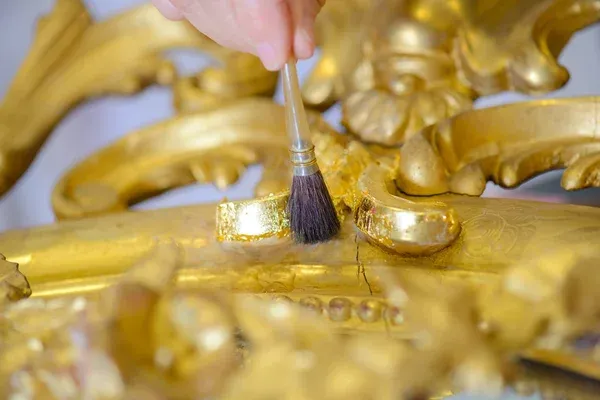
Rhodium plating is commonly used in different types of jewelry:
- White Gold Rhodium Plating: White gold jewelry is almost always rhodium plated. This is because pure white gold tends to have a yellowish tint, and rhodium plating gives it a bright, white finish.
- Silver Rhodium Plating: Silver is also often rhodium plated to prevent tarnishing and to give it a more durable, polished appearance.
- Platinum Rhodium Plating: Although platinum is a naturally white metal, rhodium plating is sometimes applied to enhance its shine or protect it from scratches.
Benefits of Rhodium Plating
- Enhanced Appearance: Rhodium has a highly reflective and mirror-like finish. It makes jewelry look shinier and more aesthetically appealing, especially in white gold or platinum pieces.
- Increased Durability: Rhodium is a hard metal, so plating adds a layer of protection against scratches and abrasions.
- Tarnish Resistance: Rhodium is resistant to corrosion and tarnish. Silver, in particular, benefits from this as it can tarnish easily without protection.
- Hypoallergenic Properties: Rhodium plating helps to create a hypoallergenic surface, making jewelry safe for people with sensitive skin, especially if the base metal contains nickel or other irritants.
- Non-Toxic: Rhodium is non-toxic and does not oxidize easily, so it’s safe for everyday wear.
How Long Does Rhodium Plating Last?
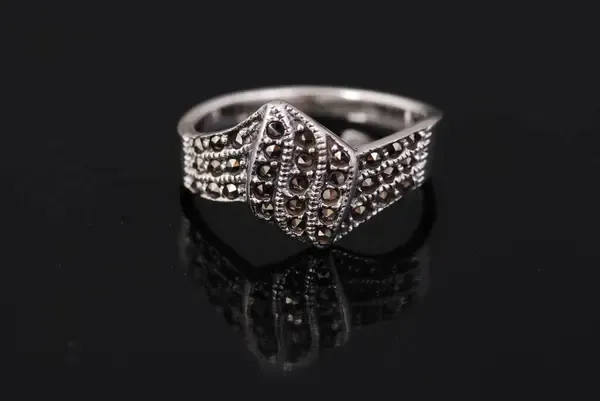
The lifespan of rhodium plating depends on several factors such as the thickness of the plating, how often the jewelry is worn, and the type of jewelry. Replating can be done periodically to maintain the piece’s luster.
Rhodium plating is not permanent and will wear off with regular use and exposure to sweat, lotions, cosmetics, and other common materials. For a white gold engagement ring, re-plating is typically needed every 1-3 years, but this can vary based on the wear and tear and the thickness of the plating.
The standard thickness of rhodium plating for a ring is usually 0.75 to 1.0 microns. This is very thin but is considered ideal for rings and other jewelry that undergo rough wear. If the plating is too thick, it can become brittle and crack. On the other hand, if it is too thin, the jewelry can discolor more quickly.
Most jewelers provide a rhodium re-plating service for jewelry, which usually costs between $50-150, depending on the thickness and size of the piece.
Downsides of Rhodium Plating
- Wears Off Over Time: Rhodium plating is not permanent. Over time, especially with daily wear, it can wear off, revealing the underlying metal.
- Cost: Rhodium is an expensive metal, so the process of plating can add to the cost of jewelry maintenance.
- Requires Regular Maintenance: Since it can wear off, rhodium-plated jewelry may need to be replated every so often to maintain its appearance.
- Not Suitable for All Jewelry: Rhodium plating is not recommended for certain types of jewelry, such as yellow or rose gold, as it can alter the intended color.
Cost of rhodium plating
The cost of rhodium plating depends on several factors. As a precious metal, it costs more than other coatings. The total cost of your project depends on multiple aspects of the process, including whether you choose rack or barrel electroplating, the thickness of the coating you require, whether you need Type 1 or Type 2 coating, the size of your project, and if you need any additional services.
Replating rhodium costs between $40 and $100. It is not time-consuming but is a complicated process. Rhodium is more expensive than any other metal, but rhodium plating is less costly than solid gold or platinum. The price of your rhodium-plated jewelry depends on the value of the base metal. If it were possible to create a solid rhodium ring, then it would be incredibly expensive.
Care Tips for Rhodium-Plated Jewelry

- Avoid Harsh Chemicals: Cleaners, bleach, and even some soaps can cause the rhodium layer to wear off faster.
- Remove Before Activities: Taking off rhodium-plated jewelry before engaging in sports, cleaning, or swimming can prolong its life.
- Use a Soft Cloth for Cleaning: To clean rhodium-plated jewelry, use a soft, non-abrasive cloth. Avoid harsh brushes or rough clothes.
Conclusion
Rhodium plating is a popular process used to enhance the appearance and durability of jewelry, particularly white gold, silver, and platinum pieces. It involves applying a thin layer of rhodium to the jewelry to create a brilliant, mirror-like finish that resists tarnishing and scratching.
The plating also makes the jewelry hypoallergenic. However, it’s not permanent and can wear off over time, especially on frequently worn items like rings, requiring replating every 6 months to a few years. To maintain rhodium-plated jewelry, avoiding harsh chemicals and removing the pieces during strenuous activities is important. Overall, rhodium plating significantly improves both the aesthetics and longevity of jewelry.
FAQ’s
Does rhodium turn skin green?
Rhodium does not turn skin green. It is non-reactive and hypoallergenic, making it an excellent choice to prevent discoloration or allergic reactions. If jewelry causes skin to turn green, the rhodium plating may have worn off, exposing reactive metals underneath. Regular maintenance and replating can help prevent this issue.
Does rhodium plating tarnish?
Rhodium is nickel-free, so it does not tarnish. It is also corrosion-resistant and does not rust. Due to its strength, rhodium does not require alloying with other metals like nickel or copper, which can corrode over time and leave dark green marks on your skin.
Is rhodium hypoallergenic?
Rhodium is hypoallergenic because it lacks nickel, which can cause severe skin reactions. It acts as a barrier against other metals that are alloyed with nickel, keeping your skin safe. If you have a nickel allergy or simply want to protect your skin, rhodium is an excellent choice for you.
What is rhodium-plated sterling silver?
Rhodium-plated silver is sterling silver that has been coated in rhodium to make it appear whiter and brighter. Since silver is a softer metal, rhodium helps protect it from scratches and wear. Sterling silver consists of 92.5% silver and 7.5% of other metals such as copper, nickel, or a combination of the two. The presence of copper and nickel in sterling silver causes it to tarnish. However, rhodium plating prevents this from occurring.
Which is better, rhodium plated or sterling silver?
Whether you prefer rhodium-plated or sterling silver jewelry is a matter of personal preference. However, Rhodium-plated and sterling silver jewelry complement each other well. Sterling silver contains nickel and copper, which can cause tarnishing and turn your skin green over time.However, when coated with a layer of rhodium, silver becomes a better metal. Rhodium protects your skin from the small amount of nickel in silver and eliminates the risk of tarnishing.
Does Rhodium plated brass last longer?
It is not advisable to use brass as a base metal underneath rhodium in fine jewelry. This is because brass is inexpensive, while rhodium is a precious metal. Due to the low cost of brass, only a thin layer of rhodium can be applied, which wears off quickly. While rhodium plating can improve the durability of brass, it is not a wise investment as rhodium plated brass jewelry would need frequent replacement. Ultimately, the maintenance costs would likely exceed the value of the jewelry.
Is a silver jewel covered with rhodium more expensive?
Rhodium electroplated allows the plating of precious metal, with rhodium atoms being chemically fixed on those of silver through the passage of a current in the jewel and deposits a very regular and resistant layer, typically 1 to 5 microns thick. The quality and resistance of the plating depend on the thickness deposited. As of the end of 2020, rhodium was valued at about €600,000 per kilo, compared to €46,000 per kilo of gold and €700 per kilo of silver. For a ring, the cost increases by €5 to €15 based on the thickness of the plating.
